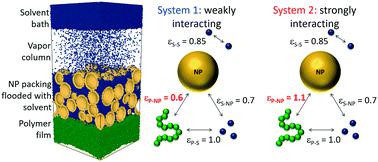当前位置:
X-MOL 学术
›
Mol. Syst. Des. Eng.
›
论文详情
Our official English website, www.x-mol.net, welcomes your
feedback! (Note: you will need to create a separate account there.)
Effect of polymer–nanoparticle interactions on solvent-driven infiltration of polymer (SIP) into nanoparticle packings: a molecular dynamics study
Molecular Systems Design & Engineering ( IF 3.2 ) Pub Date : 2019-12-20 , DOI: 10.1039/c9me00148d R. Bharath Venkatesh 1, 2, 3, 4 , Tianren Zhang 1, 2, 3, 4 , Neha Manohar 1, 2, 3, 4 , Kathleen J. Stebe 1, 2, 3, 4 , Robert A. Riggleman 1, 2, 3, 4 , Daeyeon Lee 1, 2, 3, 4
Molecular Systems Design & Engineering ( IF 3.2 ) Pub Date : 2019-12-20 , DOI: 10.1039/c9me00148d R. Bharath Venkatesh 1, 2, 3, 4 , Tianren Zhang 1, 2, 3, 4 , Neha Manohar 1, 2, 3, 4 , Kathleen J. Stebe 1, 2, 3, 4 , Robert A. Riggleman 1, 2, 3, 4 , Daeyeon Lee 1, 2, 3, 4
Affiliation

|
Naturally occurring nanocomposites like nacre owe their exceptional mechanical properties to high loadings of platelets that are bridged by small volume fractions of polymers. Polymer infiltration into dense assemblies of nanoparticles provides a powerful and potentially scalable approach to manufacture bio-inspired nanocomposites that mimic nacre's architecture. Solvent-driven infiltration of polymers (SIP) into nanoparticle packings formed on top of glassy polymer films is induced via capillary condensation of a solvent in the interstitial voids between nanoparticles (NP), followed by plasticization and transport of polymers into the liquid-filled pores, leading to the formation of the nanocomposite structure. To understand the effect of polymer–nanoparticle interactions on the dynamics of polymer infiltration in SIP, we perform molecular dynamics simulations. The mechanism of polymer infiltration and the influence of interactions between polymer and NPs on the dynamics of the process are investigated. Depending on the strength of interaction, polymer infiltration either follows (a) dissolution-dominated infiltration where plasticized polymer chains remain solvated in the pores and rapidly diffuse into the packing or (b) adhesion-dominated transport where the chains adsorb onto the nanoparticle surface and move slowly through the nanoparticle film as a well-defined front. A non-monotonic trend emerges as the adhesion strength is increased; the infiltration of chains becomes faster with the co-operative effect of adhesion and dissolution as adhesion increases but eventually slows down when the polymer–nanoparticle adhesion dominates.
中文翻译:

聚合物-纳米粒子相互作用对溶剂驱动的聚合物(SIP)渗入纳米粒子填料的影响:分子动力学研究
天然存在的纳米复合材料(如珍珠母)具有出色的机械性能,这归因于血小板的高负载量,而血小板的负载量很小。聚合物渗透到纳米颗粒的致密组件中,提供了一种强大且具有潜在可扩展性的方法来制造仿珍珠母结构的受生物启发的纳米复合材料。溶剂驱动的聚合物(SIP)渗透到玻璃状聚合物薄膜顶部形成的纳米颗粒填料中是通过溶剂在纳米颗粒(NP)之间的空隙中发生毛细管缩合,然后塑化并将聚合物运输到液体填充的孔隙中,从而导致纳米复合结构的形成。为了了解聚合物-纳米粒子相互作用对SIP中聚合物渗透动力学的影响,我们进行了分子动力学模拟。研究了聚合物渗透的机理以及聚合物与NP之间相互作用对过程动力学的影响。根据互动的强度,聚合物的渗透要么是(a)溶解为主的渗透,其中增塑的聚合物链保持在孔中溶剂化并迅速扩散到填料中,要么(b)粘附为主的运输,其中链吸附到纳米颗粒表面并缓慢移动通过纳米颗粒薄膜定义明确的战线 随着粘合强度的增加,出现非单调的趋势。随着粘附力的增加,链的渗透随着粘附力和溶解的协同作用而变得更快,但是当聚合物-纳米颗粒的粘附力占主导时,最终渗透速度会减慢。
更新日期:2019-12-20
中文翻译:

聚合物-纳米粒子相互作用对溶剂驱动的聚合物(SIP)渗入纳米粒子填料的影响:分子动力学研究
天然存在的纳米复合材料(如珍珠母)具有出色的机械性能,这归因于血小板的高负载量,而血小板的负载量很小。聚合物渗透到纳米颗粒的致密组件中,提供了一种强大且具有潜在可扩展性的方法来制造仿珍珠母结构的受生物启发的纳米复合材料。溶剂驱动的聚合物(SIP)渗透到玻璃状聚合物薄膜顶部形成的纳米颗粒填料中是通过溶剂在纳米颗粒(NP)之间的空隙中发生毛细管缩合,然后塑化并将聚合物运输到液体填充的孔隙中,从而导致纳米复合结构的形成。为了了解聚合物-纳米粒子相互作用对SIP中聚合物渗透动力学的影响,我们进行了分子动力学模拟。研究了聚合物渗透的机理以及聚合物与NP之间相互作用对过程动力学的影响。根据互动的强度,聚合物的渗透要么是(a)溶解为主的渗透,其中增塑的聚合物链保持在孔中溶剂化并迅速扩散到填料中,要么(b)粘附为主的运输,其中链吸附到纳米颗粒表面并缓慢移动通过纳米颗粒薄膜定义明确的战线 随着粘合强度的增加,出现非单调的趋势。随着粘附力的增加,链的渗透随着粘附力和溶解的协同作用而变得更快,但是当聚合物-纳米颗粒的粘附力占主导时,最终渗透速度会减慢。











































 京公网安备 11010802027423号
京公网安备 11010802027423号